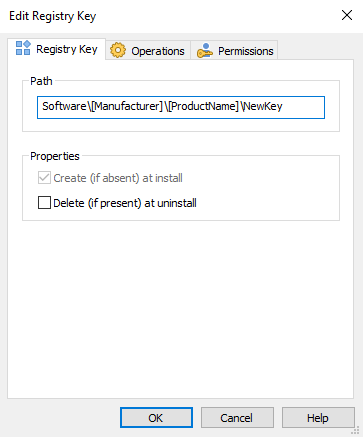
Exploring the Functions of a Registry Keys Tab

Exploring the Functions of a Registry Keys Tab
Table of Contents
- Introduction
- Registration
- Using Advanced Installer
- GUI
- Working with Projects
- Installer Project
* Product Information
* Resources
* Files and Folders
* Tiles
* Java Products
* Registry
* Registry Value Dialog
* Registry Value Removal Dialog
* Registry Key Dialog
* Registry Key Tab
* Registry Key Operations Tab
* Permissions Tab - Installer Project
* App-V Options Tab - Registry Key Dialog
* Registry Picker Dialog
* Registry Key Picker Dialog
* Import Registry File (Advanced)
* Wow6432Node Registry Key
* File Associations
* Assemblies
* Drivers
* Services
* Package Definition
* Requirements
* User Interface
* System Changes
* Server
* Custom Behavior - Patch Project
- Merge Module Project
- Updates Configuration Project
- Windows Store App Project
- Modification Package Project
- Optional Package Project
- Windows Mobile CAB Projects
- Visual Studio Extension Project
- Software Installer Wizards - Advanced Installer
- Visual Studio integration
- Alternative to AdminStudio/Wise
- Replace Wise
- Migrating from Visual Studio Installer
- Keyboard Shortcuts
- Shell Integration
- Command Line
- Advanced Installer PowerShell Automation Interfaces
- Features and Functionality
- Tutorials
- Samples
- How-tos
- FAQs
- Windows Installer
- Deployment Technologies
- IT Pro
- MSIX
- Video Tutorials
- Advanced Installer Blog
- Table of Contents
Disclaimer: This post includes affiliate links
If you click on a link and make a purchase, I may receive a commission at no extra cost to you.
Registry Key Tab

Registry Key
Path
This points at the registry’s key location. This path is localized .
Properties
- Create (if absent) at install
- this option makes sense only if the registry key does not contain a value. If this option is selected the registry key will be created at install time if it is not present.
- Delete (if present) at uninstall
- with this option enabled the key is to be deleted, if present, with all of its values and subkeys, when the component is uninstalled. The key will also be deleted even if no values are in it.
If the registry key contains at least a value these options are not needed. The registry key will be automatically created at install time and deleted during uninstall.
Did you find this page useful?
Please give it a rating:
Thanks!
Report a problem on this page
Information is incorrect or missing
Information is unclear or confusing
Something else
Can you tell us what’s wrong?
Send message
Also read:
- [New] Mastering Sound Capture in Windows 11
- [Updated] 2024 Approved Pinnacle Avi Player Mobile & Desktop Excellence
- [Updated] In 2024, Most Innovative Voice-Altering Mobile Apps
- 1. Speedy Methods for Shrinking Your PDF Documents
- 3uTools Virtual Location Not Working On Samsung Galaxy F04? Fix Now | Dr.fone
- AI Frame Interpolation: Miglioramento Dei Fotogrammi Al Secondo (FPS) E Transizioni Senza Soluzione Di Continuità
- How to Get the Newest Brother MFC-J480DW Printer Drivers on Your Windows Machine
- In 2024, Best Ways on How to Unlock/Bypass/Swipe/Remove Samsung Galaxy S23+ Fingerprint Lock
- Leading Free Internet Tools for Turning Videos Into Songs and Podcasts
- Maximizing Your Experience: A Guide to Understanding the Sign-Up Section
- Setting Up Your Preferences: A Detailed Guide to the Configuration Panel
- Simple Strategies for Seamlessly Mirroring Your Android Device Onto an iPad
- Syncing Your Android Device with Panasonic TV: A Step-by-Step Guide
- Title: Exploring the Functions of a Registry Keys Tab
- Author: Steven
- Created at : 2024-10-10 01:08:37
- Updated at : 2024-10-10 20:47:44
- Link: https://fox-zero.techidaily.com/exploring-the-functions-of-a-registry-keys-tab/
- License: This work is licensed under CC BY-NC-SA 4.0.